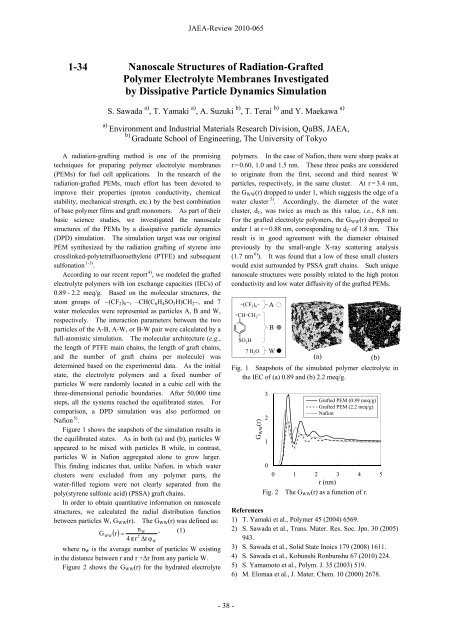JAEA-Review-2010-065.pdf:15.99MB - 日本原子力研究開発機構
JAEA-Review-2010-065.pdf:15.99MB - 日本原子力研究開発機構
JAEA-Review-2010-065.pdf:15.99MB - 日本原子力研究開発機構
Create successful ePaper yourself
Turn your PDF publications into a flip-book with our unique Google optimized e-Paper software.
1-34<br />
Nanoscale Structures of Radiation-Grafted<br />
Polymer Electrolyte Membranes Investigated<br />
by Dissipative Particle Dynamics Simulation<br />
S. Sawada a) , T. Yamaki a) , A. Suzuki b) , T. Terai b) and Y. Maekawa a)<br />
a) Environment and Industrial Materials Research Division, QuBS, <strong>JAEA</strong>,<br />
b) Graduate School of Engineering, The University of Tokyo<br />
A radiation-grafting method is one of the promising<br />
techniques for preparing polymer electrolyte membranes<br />
(PEMs) for fuel cell applications. In the research of the<br />
radiation-grafted PEMs, much effort has been devoted to<br />
improve their properties (proton conductivity, chemical<br />
stability, mechanical strength, etc.) by the best combination<br />
of base polymer films and graft monomers. As part of their<br />
basic science studies, we investigated the nanoscale<br />
structures of the PEMs by a dissipative particle dynamics<br />
(DPD) simulation. The simulation target was our original<br />
PEM synthesized by the radiation grafting of styrene into<br />
crosslinked-polytetrafluoroethylene (PTFE) and subsequent<br />
1-3)<br />
sulfonation .<br />
4)<br />
According to our recent report , we modeled the grafted<br />
electrolyte polymers with ion exchange capacities (IECs) of<br />
0.89 - 2.2 meq/g. Based on the molecular structures, the<br />
atom groups of (CF2) 6 –CH(C6H4SO3H)CH2, and 7<br />
water molecules were represented as particles A, B and W,<br />
respectively. The interaction parameters between the two<br />
particles of the A-B, A-W, or B-W pair were calculated by a<br />
full-atomistic simulation. The molecular architecture (e.g.,<br />
the length of PTFE main chains, the length of graft chains,<br />
and the number of graft chains per molecule) was<br />
determined based on the experimental data. As the initial<br />
state, the electrolyte polymers and a fixed number of<br />
particles W were randomly located in a cubic cell with the<br />
three-dimensional periodic boundaries. After 50,000 time<br />
steps, all the systems reached the equilibrated states. For<br />
comparison, a DPD simulation was also performed on<br />
5)<br />
Nafion .<br />
Figure 1 shows the snapshots of the simulation results in<br />
the equilibrated states. As in both (a) and (b), particles W<br />
appeared to be mixed with particles B while, in contrast,<br />
particles W in Nafion aggregated alone to grow larger.<br />
This finding indicates that, unlike Nafion, in which water<br />
clusters were excluded from any polymer parts, the<br />
water-filled regions were not clearly separated from the<br />
poly(styrene sulfonic acid) (PSSA) graft chains.<br />
In order to obtain quantitative information on nanoscale<br />
structures, we calculated the radial distribution function<br />
between particles W, GWW(r). The GWW(r) was defined as:<br />
n W<br />
GWW<br />
r <br />
, (1)<br />
2<br />
4π<br />
r r<br />
φW<br />
where nW is the average number of particles W existing<br />
in the distance between r and r +Δr from any particle W.<br />
Figure 2 shows the GWW(r) for the hydrated electrolyte<br />
<strong>JAEA</strong>-<strong>Review</strong> <strong>2010</strong>-065<br />
- 38 -<br />
polymers. In the case of Nafion, there were sharp peaks at<br />
r = 0.60, 1.0 and 1.5 nm. These three peaks are considered<br />
to originate from the first, second and third nearest W<br />
particles, respectively, in the same cluster. At r = 3.4 nm,<br />
the GWW(r) dropped to under 1, which suggests the edge of a<br />
5)<br />
water cluster . Accordingly, the diameter of the water<br />
cluster, dC, was twice as much as this value, i.e., 6.8 nm.<br />
For the grafted electrolyte polymers, the GWW(r) dropped to<br />
under 1 at r = 0.88 nm, corresponding to dC of 1.8 nm. This<br />
result is in good agreement with the diameter obtained<br />
previously by the small-angle X-ray scattering analysis<br />
6)<br />
(1.7 nm ). It was found that a low of these small clusters<br />
would exist surrounded by PSSA graft chains. Such unique<br />
nanoscale structures were possibly related to the high proton<br />
conductivity and low water diffusivity of the grafted PEMs.<br />
-(CF 2) 6-<br />
-CH-CH 2-<br />
SO 3 H<br />
A<br />
B<br />
7H2O W<br />
(a) (b)<br />
Fig. 1 Snapshots of the simulated polymer electrolyte in<br />
the IEC of (a) 0.89 and (b) 2.2 meq/g.<br />
G WW(r)<br />
3<br />
2<br />
1<br />
Grafted PEM (0.89 meq/g)<br />
Grafted PEM (2.2 meq/g)<br />
Nafion<br />
0<br />
0 1 2 3 4 5<br />
r (nm)<br />
Fig. 2 The GWW(r) as a function of r.<br />
References<br />
1) T. Yamaki et al., Polymer 45 (2004) 6569.<br />
2) S. Sawada et al., Trans. Mater. Res. Soc. Jpn. 30 (2005)<br />
943.<br />
3) S. Sawada et al., Solid State Inoics 179 (2008) 1611.<br />
4) S. Sawada et al., Kobunshi Ronbunshu 67 (<strong>2010</strong>) 224.<br />
5) S. Yamamoto et al., Polym. J. 35 (2003) 519.<br />
6) M. Elomaa et al., J. Mater. Chem. 10 (2000) 2678.

















